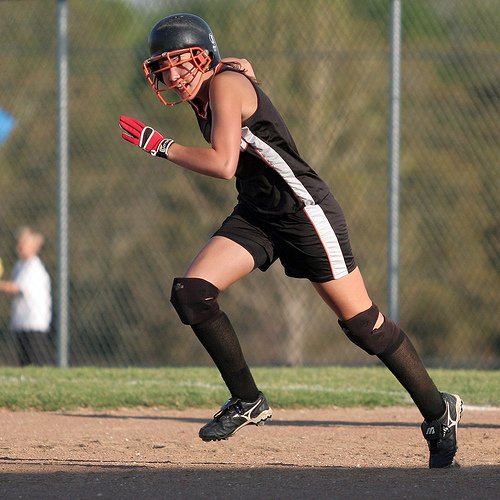
Do you “still” run around forever or do hours and hours of “slow-go” cardio on treadmills or stationary bikes?
May I tell you something… we are in the 21st century! These practices are out of date for softball.
They are what we call “old school” stuff that has since been replaced by much better practices.
For a very long time, an old classic in baseball and softball training has been to do a lot of aerobic conditioning, mostly in the form of distance running.
Aerobic conditioning is defined as any form of activity that is sustained for a certain amount of time with the intention of increasing endurance and the capacity of our cardiovascular system.
Too much aerobic conditioning is a deadly softball mistake!
Let me explain.
Our body consists of three main energy systems:
System #1 – the speed system (a.k.a. anaerobic alatic system or ATP-PC system): this system provides us with energy for any effort lasting less than 10 seconds. It is a very powerful system but it gets completely empty after 10-12 seconds. This is the first energy system to kick-in when we start moving.
System #2 – the speed endurance system (a.k.a. anaerobic lactic system or lactic acid system): this system provides us with energy for any effort lasting between 10 seconds and 2 minutes. This system is fairly powerful and has a bit more endurance than the first system.
It is also the system that produces a lot of lactic acid and give us that muscle burning sensation when we workout or do some intense effort for more than 10 seconds.
System #3 – the endurance system (a.k.a. aerobic system): this system provides us with energy for any effort lasting more than 2 minutes. This is system is not very powerful but can last for up to several hours.
In summary, for any effort that is short (less than 10 seconds) and very intense, the first energy system will fuel that effort.
If an effort is a little longer but still fairly short (between 10 seconds and 2 minutes) and still intense, the second energy system will provide the energy to sustain that effort.
Finally, if the effort tends to be longer (more than 2 minutes) and less intense, the third energy system will take care of it.
As you know, you get better at what you practice. If you hit, you will get better at hitting and if you field balls, you will get better at fielding balls.
The same idea applies to energy system training. If you run for a long time, you are training the third energy system (endurance system) and will improve your ability to run for quite a while. If you do short, intense sprints, you are training the first energy system (speed system) and therefore improving your ability to be explosive and run fast.
Smart coaches train the energy systems that match the demands of their sport. For example, Triathlon coaches will focus on training the endurance system while sprint coaches will focus on the speed system.
That just makes sense.
In the case of softball, most plays last 5 seconds or less. Therefore, it is the powerful – speed system – that fuels just about every action in softball.
As you can see, if someone spends too much time training the aerobic system (third energy system), they are not training the right system for our sport. The endurance system (aerobic system) does not play a big role in softball.
However, there are still benefits for softball players to doing some “cardio” or developing a base of aerobic endurance.
A good base of aerobic endurance will serve as a foundation to develop the speed system much faster.
Here is a list of the other main benefits of doing “cardio training” for softball players:
- Control of body fat
- Ability to recover more quickly after an intense effort
- Increased stamina and resistance to fatigue
- Decreased tension and aid in sleeping
- Psychological benefits as exercise improves mood, reduces depression and anxiety
Moreover, it’s also true that pitchers and catchers will benefit from a certain base of aerobic conditioning because their position requires more stamina.
However, overemphasizing aerobic conditioning is detrimental to all softball players; including pitchers and catchers.
Once you reach an acceptable level of aerobic conditioning (i.e. run at average speed for 30 minutes), there is no need to further increase it.
At that point you should mostly maintain your aerobic base by doing 1-2 aerobic sessions a week (i.e. run for 20-30 minutes at an average pace).
More than that will be detrimental to your game. Not only is it a waste of time because it’s not useful on the field but it also hinder the development of speed, power, and strength.
Is that what we want? Definitely not! For sprinters, doing aerobic conditioning is almost a sin. They avoid it because it is detrimental to their performance!
On the other side, long distance runners don’t waste their time doing many sprints because they need to increase their endurance! Softball players including pitchers and catchers are like sprinters; they need to be quick, explosive and powerful.
So, what I am saying is that a base of aerobic conditioning is beneficial for the reasons mentioned above. However, doing too much of it will be detrimental. Once you have reached a certain level of endurance, you need to focus on building speed, power, and strength. This is what you truly need on the field!
Also, most of your endurance building work should be in the off-season. In pre-season (2-3 months prior to the beginning of the season), you should mostly focus on building speed and power. During the season, your goal is to maintain your current fitness level where it is.
Stop running around and start sprinting. You game will thank you.
So, are you still running around like a fool?